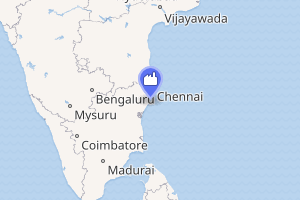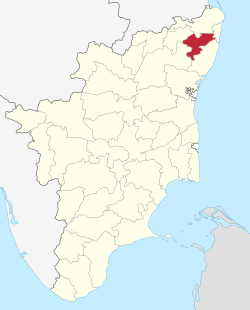Madras Atomic Power Station
Madras Atomic Power Station (MAPS) located at Kalpakkam about 80 kilometres (50 mi) south of Chennai, India, is a comprehensive nuclear power production, fuel reprocessing, and waste treatment facility that includes plutonium fuel fabrication for fast breeder reactors (FBRs). It is also India's first fully indigenously constructed nuclear power station, with two units each generating 220 MW of electricity. The first and second units of the station went critical in 1983 and 1985, respectively. The station has reactors housed in a reactor building with double shell containment improving protection also in the case of a loss-of-coolant accident. An Interim Storage Facility (ISF) is also located in Kalpakkam.
| Madras Atomic Power station | |
|---|---|
.jpg) | |

| |
| Country | India |
| Coordinates | 12°33′27″N 80°10′30″E |
| Status | Operational |
| Construction began | 1970 |
| Commission date | 24 January 1984 |
| Operator(s) | Nuclear power Corporation of India Ltd |
| Nuclear power station | |
| Reactor type | FBR |
| Power generation | |
| Units operational | 2 × 235 MW |
| Units planned | 2 × 600 MW |
| Units under const. | 1 × 500 MW |
| Nameplate capacity | 470 MW |
| Capacity factor | 56.1% |
| Annual net output | 2,311 GW·h |
| External links | |
| Website | Nuclear power Corporation of India Ltd |
| Commons | Related media on Commons |
History
During its construction, a total of 3.8 lakh (380,000) railway sleeper (logs) were brought from all over India to lift the 180 ton critical equipment in the first unit, due to lack of proper infrastructure and handling equipment.[1]
As of July 2016 the Prototype Fast Breeder Reactor (PFBR) was in its final construction stage, and was expected to reach criticality in March 2017 with 500 MW of electricity production.[2] The following month the loading of the 1750 ton liquid sodium coolant were expected to happen in four to five months, with sources in the Department of Atomic Energy reporting that criticality would likely be reached only around May 2017.[3]
Reactors
The facility houses two indigenously built Pressurised Heavy-Water Reactors (PHWRs), MAPS-1 and MAPS-2 designed to produce 235 MW of electricity each.[4] MAPS-1 was completed in 1981, but start-up was delayed due to a shortage of heavy water. After procuring the necessary heavy water, MAPS-1 went critical in 1983 and began operating at full power on 27 January 1984. MAPS-2 obtained criticality in 1985 and began full power operations on 21 March 1986.[4][5]
With India not being a signatory to the Treaty on the Non-Proliferation of Nuclear Weapons the reactors have since 1985 been delivering their spent fuel to the nuclear reprocessing plant at Tarapur, providing the country with unsafeguarded plutonium.[4]
A beachhead at Kalpakkam also hosts India's first indigenous Pressurised (light) water reactor (PWR). The 80 MW reactor was developed by Bhabha Atomic Research Centre (BARC) as the land-based prototype of the nuclear power unit for India's nuclear submarines.[6] This unit does not come under MAPS.
Incidents
The reactors' coolant pipes have been plagued by vibrations and cracking with substantial cracking in the reactor coolant system. This cracking has led to the discovery of Zircaloy pieces in a moderator pump, requiring the power generation to be lowered to 170 MW.[4]
On 26 March 1999 large amounts of heavy water spilled at MAPS-2, exposing seven technicians to heavy doses of radiation.[4]
References
- "MAPS Silver Jubilee Celebration". indiaenvironmentportal.org.in. India Environment Portal. Archived from the original on 18 December 2012.
- Singh, Jitendra (28 July 2016). "Answer on 28.07.2016 to Rajya Sabha unstarred question no.1184 to Government of India Department of Atomic Energy" (PDF). dae.nic.in. Department of Atomic Energy, Government of India. Archived from the original (PDF) on 8 August 2016. Retrieved 8 August 2016.
PFBR is poised for first criticality by March, 2017.
- Rohit, T.K. (30 July 2016). "Prototype Fast Breeder Reactor likely to be delayed". The Hindu. Archived from the original on 30 July 2016. Retrieved 8 August 2016.
- "NTI: Country Overviews: India: Nuclear Facilities Madras Atomic Power Station (MAPS)". Nuclear Threat Initiative. September 2003. Archived from the original on 17 March 2004. Retrieved 18 February 2017.
- Plants Under Operation - Nuclear Power Corporation of India Limited Archived 8 November 2014 at the Wayback Machine. Npcil.nic.in. Retrieved on 2013-12-06.
- "PWR building shows indigenous capability, says Kakodkar". The Hindu. Chennai, India. 3 August 2009.
External links
- Nuclear power Corporation of India Ltd
- Plants Under Operation: Madras Atomic Power Station
- NTI India Profile
